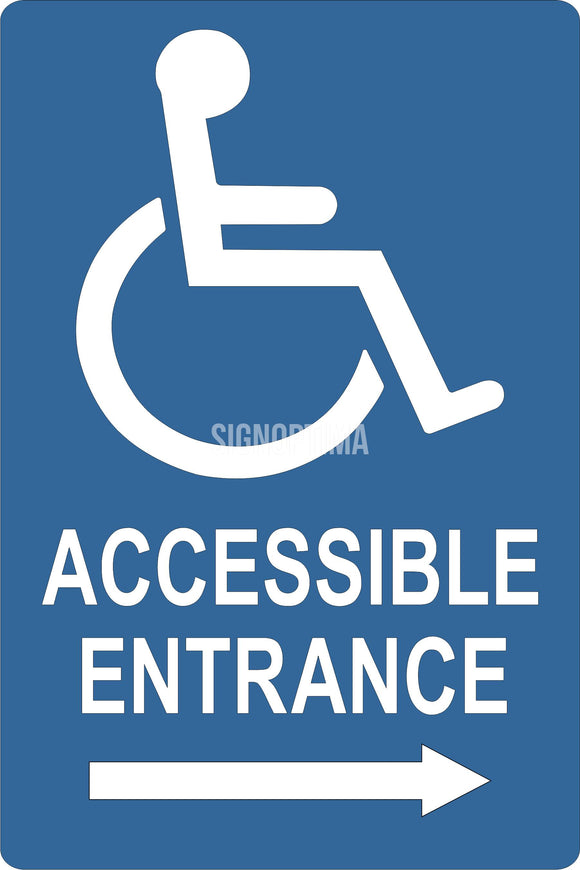ADA Signs: Important Devices for Inclusive Atmospheres
ADA Signs: Important Devices for Inclusive Atmospheres
Blog Article
Checking Out the Key Attributes of ADA Signs for Boosted Accessibility
In the world of ease of access, ADA signs offer as quiet yet powerful allies, guaranteeing that areas are accessible and inclusive for people with handicaps. By integrating Braille and tactile aspects, these indications break obstacles for the aesthetically damaged, while high-contrast shade plans and understandable fonts provide to varied aesthetic demands.
Significance of ADA Conformity
Making sure compliance with the Americans with Disabilities Act (ADA) is essential for cultivating inclusivity and equivalent access in public rooms and workplaces. The ADA, passed in 1990, mandates that all public centers, employers, and transportation solutions fit individuals with disabilities, ensuring they enjoy the very same civil liberties and chances as others. Compliance with ADA standards not only meets legal obligations yet additionally improves an organization's online reputation by demonstrating its dedication to diversity and inclusivity.
Among the essential elements of ADA conformity is the execution of easily accessible signage. ADA indicators are developed to guarantee that people with disabilities can easily navigate with areas and buildings. These signs should abide by details standards relating to size, font style, shade comparison, and placement to ensure exposure and readability for all. Effectively carried out ADA signage aids eliminate barriers that people with disabilities frequently encounter, consequently advertising their freedom and self-confidence (ADA Signs).
Furthermore, adhering to ADA laws can reduce the risk of possible fines and lawful effects. Organizations that fail to abide by ADA guidelines might deal with penalties or legal actions, which can be both financially challenging and destructive to their public picture. Therefore, ADA compliance is essential to promoting an equitable environment for every person.
Braille and Tactile Components
The unification of Braille and responsive aspects right into ADA signage embodies the concepts of accessibility and inclusivity. These features are important for people who are aesthetically impaired or blind, enabling them to browse public areas with higher self-reliance and confidence. Braille, a tactile writing system, is crucial in offering created information in a style that can be easily perceived through touch. It is commonly positioned below the equivalent text on signage to make certain that people can access the information without aesthetic assistance.
Tactile aspects expand past Braille and consist of elevated icons and personalities. These elements are designed to be noticeable by touch, permitting individuals to determine room numbers, bathrooms, departures, and various other vital locations. The ADA sets particular guidelines regarding the dimension, spacing, and placement of these responsive aspects to maximize readability and make sure uniformity throughout various atmospheres.

High-Contrast Color Plans
High-contrast color pattern play a critical duty in boosting the exposure and readability of ADA signage for individuals with visual disabilities. These schemes are important as they optimize the difference in light reflectance between text and history, making certain that signs are conveniently noticeable, even from a range. The Americans with Disabilities Act (ADA) mandates the usage of details color contrasts to accommodate those with restricted vision, making it an essential aspect of conformity.
The effectiveness of high-contrast shades depends on their capability to stand apart in numerous illumination problems, including dimly lit settings and locations with glow. Normally, dark message on a light history or light message on a dark history is used to accomplish optimal contrast. Black message on a white or yellow background supplies a stark aesthetic distinction that helps in fast acknowledgment and comprehension.

Legible Fonts and Text Size
When considering the style of ADA signage, the option of understandable font styles and appropriate text size can not be overstated. These elements are essential for ensuring that indicators come to individuals with aesthetic problems. The Americans with Disabilities Act (ADA) mandates that fonts should be not italic and sans-serif, oblique, script, very ornamental, or of unusual type. These requirements help make certain that the message is quickly legible from a distance which the personalities are distinguishable to diverse audiences.
The size of the text additionally plays a pivotal function in ease of access. According to ADA guidelines, the minimal text height must be 5/8 inch, and it should raise proportionally with watching distance. This is especially essential in public rooms where signage requirements to be checked out promptly and precisely. Uniformity in message dimension adds to a natural visual experience, assisting individuals in navigating settings effectively.
Moreover, spacing between lines and letters is integral to clarity. Adequate spacing protects against characters from showing up crowded, boosting readability. By sticking to these requirements, reference designers can considerably enhance ease of access, ensuring that signage serves its designated purpose for all individuals, no matter their aesthetic capacities.
Effective Positioning Techniques
Strategic positioning of ADA signs is necessary for optimizing accessibility and ensuring conformity with legal criteria. Correctly positioned indications guide individuals with specials needs properly, promoting navigating in public areas. Secret considerations include proximity, elevation, and presence. ADA guidelines stipulate that indicators must be installed at a height between 48 look at more info to 60 inches from the ground to guarantee they are within the line of view for both standing and seated individuals. This conventional height array is essential for inclusivity, enabling wheelchair users and individuals of differing heights to accessibility information easily.
In addition, indicators must be placed surrounding to the lock side of doors to permit easy recognition before entrance. This placement aids people locate spaces and spaces without obstruction. In instances where there is no door, indications need to be located on the closest nearby wall surface. Consistency in indication placement throughout a center boosts predictability, decreasing complication and enhancing overall user experience.

Final Thought
ADA indications play an important duty in promoting ease of access by integrating functions that resolve the demands of individuals with disabilities. These components collectively cultivate a comprehensive environment, emphasizing the value of ADA conformity in making certain equal gain access to for all.
In the realm of availability, ADA signs serve as silent yet powerful allies, ensuring that spaces are accessible and inclusive for individuals with impairments. The ADA, passed in 1990, mandates that all public centers, employers, and transport solutions accommodate individuals with specials needs, ensuring they enjoy the exact same legal rights and chances as others. ADA Signs. ADA indicators are developed to guarantee that individuals with disabilities can conveniently browse through structures and spaces. ADA guidelines specify that indicators need to be placed at an elevation in between 48 to 60 inches from the ground to guarantee they are within the line of view for both standing and seated people.ADA signs my website play a vital function in advertising ease of access by incorporating functions that resolve the requirements of individuals with disabilities
Report this page